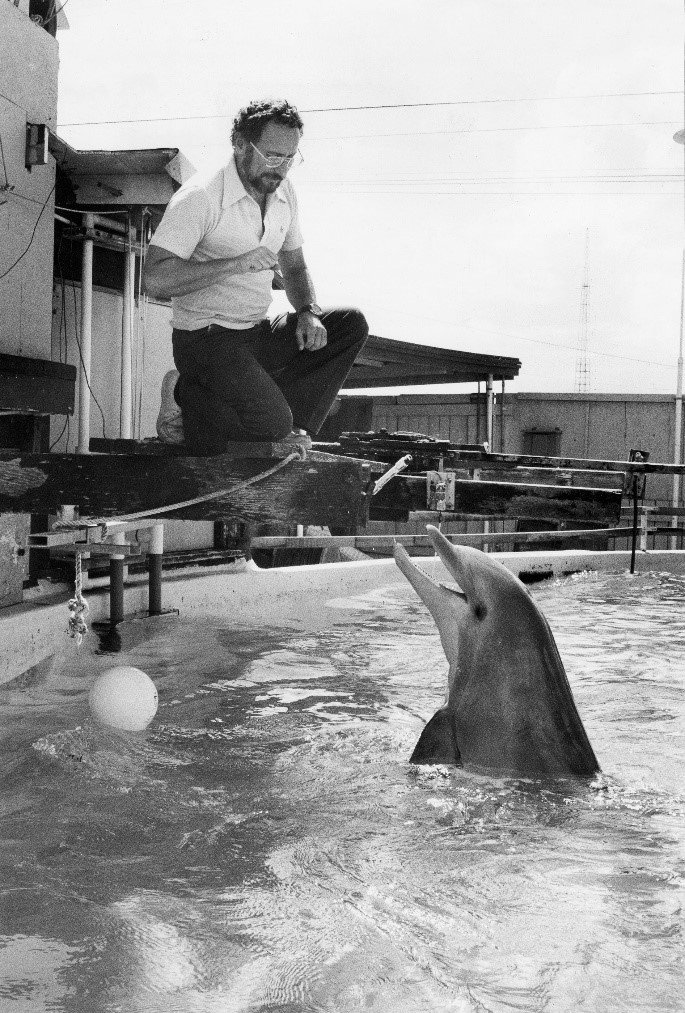After hearing of the sad passing of Professor Louis Herman, a pioneer in the field of dolphin language comprehension, we here at the Sea Watch Foundation decided to investigate more about this fascinating man and his career.
 Dr Herman and a bottlenose dolphin at the University of Hawaii in 1980
Photo credit: Walter Sullivan/New York Times
Dr Herman and a bottlenose dolphin at the University of Hawaii in 1980
Photo credit: Walter Sullivan/New York Times
The notion that many dolphin species are able to comprehend the complex syntax and semantics of artificial language has long been established within the field of marine mammal research. However, did you know that the majority of this current understanding can be traced back to the pioneering work of the late Prof Louis Herman and his team? A former intelligence officer in the American Air Force, and graduate of Pennsylvania State University, Dr Herman’s interest in dolphin language comprehension began in the early 1970s after accepting a position at the University of Hawaii, Honolulu. Having established that dolphins were indeed the distant cousins of chimpanzees, Dr Herman used a computer generated sonic language to demonstrate how two bottlenose dolphins were able to understand simple sentences such as “fetch the ball” (Herman et al., 1984). By using a combination of acoustic and visual based languages, where different sounds and visual cues represented agents, objects and actions, it was possible for Dr Herman and his team to construct hundreds of simple sentences for the dolphins to comprehend. Through instructing the two dolphins to carry out simple actions using named objects, the team were able to assess the dolphins’ levels of comprehension and conclude that both individuals were able to understand a range of simple sentence structure. Additionally, the research inferred that the two dolphins were able to modulate their responses when introduced to new objects, and report the absence of designated objects within the tank. These results constituted the first bit of convincing evidence to suggest that dolphins were able to process both semantic and syntactic sentence features.
 Photo credit: D Feingold/The Sea Watch Foundation
Photo credit: D Feingold/The Sea Watch Foundation
Following on from this success, Dr Herman went on to become a pioneer in the field of humpback whale research, shedding new light on its habitat use, migratory patterns, social organisation, feeding ecology, and use of acoustics both in Alaska and Hawaii. When a humpback whale dubbed Humphrey “the wrong way whale” became stranded in the San Francisco Bay, Dr Herman’s research into humpback whale winter migration was employed as part of the rescue operation. By playing pre-recorded sounds of humpback whales feeding, rescuers were able to successfully lure Humphrey out of the bay to safety.
Over the course of his career Dr Herman edited two books, published 160 papers, and contributed towards 230 media articles about marine mammals. He is regarded as somewhat of a legend in the field of marine mammal research, with numerous former students and staff currently collaborating to produce an “In Memoriam” paper. His final solo paper, “The multiple functions of male song within the humpback whale (Megaptera novaeangliae) mating system: review, evaluation, and synthesis” has recently been published in an online, early-view form in the journal Biological Reviews.
Dr Peter Evans, Director of Sea Watch, had these words to say after the passing of Dr Herman: “It was with great sadness back in August that I learned of the death of Louis Herman. He was 86, and was one of my heroes when I was a teenager and developing my interest in marine mammals. We corresponded a lot and he had valuable input into the book “Natural History of Whales and Dolphins” that I wrote some years ago. I remember well the last time I saw him – in March 2012 at the European Cetacean Society Conference in Galway, Ireland. Louis gave a stimulating keynote lecture on 35 years of his research, and we had dinner together afterwards. There was much to talk about and even at the age of 82, his lively mind full of interesting ideas was so impressive. His work on dolphin communication laid the foundation for a lot of the acoustics research we see today.”
For more information on Professor Louis Hermans’ life and work please see the New York Times article here.
Written by Laura Bartlett-Short and Dr Peter Evans.
























